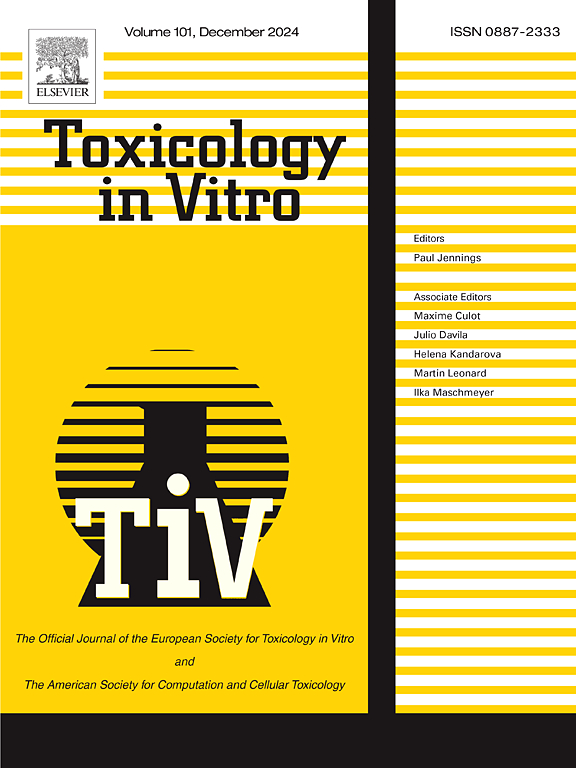TCDD inhibits the proliferation of C17.2 cells through the activation of the c-Cbl/β-catenin signaling pathway
IF 2.6
3区 医学
Q3 TOXICOLOGY
引用次数: 0
Abstract
2,3,7,8-tetrachlordibenzo-p-dioxin (TCDD) belongs to the category of persistent environmental pollutants, and gestational exposure to TCDD can lead to cognitive, memory, and motor deficits, as well as altered neuron development in rodents. However, the molecular mechanisms underlying TCDD's neurotoxicity remain unclear. Neural stem cells (NSCs) possess the capacity for self-renewal and can generate various cell types within the brain, playing fundamental roles in brain development and regeneration. This study investigated the impact of TCDD on the proliferation of mouse NSCs, specifically focusing on the C17.2 cell line. The results demonstrated that TCDD inhibited the proliferation of C17.2 cells in a dose-dependent manner. Even low doses of TCDD (5 nM) significantly reduced C17.2 cell proliferation. Regarding the molecular mechanisms, it was found that TCDD induced the degradation of β-catenin, a key regulator of cell proliferation, through the upregulation of the E3 ubiquitin ligase, casitas B-lineage lymphoma (c-Cbl), which was dependent on the aryl-hydrocarbon Receptor (AhR). Furthermore, knockdown of c-Cbl alleviated the TCDD-induced inhibition of C17.2 proliferation and of the reduction of β-catenin expression. Our research provides foundational data to understand the mechanism of TCDD-induced neurotoxicity through the inhibition of NSCs proliferation, and suggests that the c-cbl/β-catenin pathway may serve as a potential therapeutic target for countering the neurotoxicants of TCDD.
TCDD通过激活c-Cbl/β-catenin信号通路抑制C17.2细胞的增殖。
2,3,7,8-四氯二苯并-对二恶英(TCDD)属于持久性环境污染物,妊娠期暴露于TCDD可导致啮齿动物认知、记忆和运动缺陷,以及神经元发育改变。然而,TCDD神经毒性的分子机制尚不清楚。神经干细胞(Neural stem cells, NSCs)具有自我更新的能力,可以在大脑内生成各种类型的细胞,在大脑发育和再生中起着重要作用。本研究研究了TCDD对小鼠NSCs增殖的影响,特别是对C17.2细胞系的影响。结果表明,TCDD对C17.2细胞的增殖具有剂量依赖性。低剂量TCDD(5 nM)显著降低C17.2细胞增殖。分子机制方面,发现TCDD通过上调E3泛素连接酶,诱导依赖芳基烃受体(AhR)的casitas B-lineage淋巴瘤(c-Cbl) β-catenin的降解,而β-catenin是细胞增殖的关键调节因子。此外,敲低c-Cbl可减轻tcdd诱导的C17.2增殖抑制和β-catenin表达降低。我们的研究为了解TCDD通过抑制NSCs增殖诱导神经毒性的机制提供了基础数据,并提示c-cbl/β-catenin通路可能作为对抗TCDD神经毒性的潜在治疗靶点。
本文章由计算机程序翻译,如有差异,请以英文原文为准。
求助全文
约1分钟内获得全文
求助全文
来源期刊

Toxicology in Vitro
医学-毒理学
CiteScore
6.50
自引率
3.10%
发文量
181
审稿时长
65 days
期刊介绍:
Toxicology in Vitro publishes original research papers and reviews on the application and use of in vitro systems for assessing or predicting the toxic effects of chemicals and elucidating their mechanisms of action. These in vitro techniques include utilizing cell or tissue cultures, isolated cells, tissue slices, subcellular fractions, transgenic cell cultures, and cells from transgenic organisms, as well as in silico modelling. The Journal will focus on investigations that involve the development and validation of new in vitro methods, e.g. for prediction of toxic effects based on traditional and in silico modelling; on the use of methods in high-throughput toxicology and pharmacology; elucidation of mechanisms of toxic action; the application of genomics, transcriptomics and proteomics in toxicology, as well as on comparative studies that characterise the relationship between in vitro and in vivo findings. The Journal strongly encourages the submission of manuscripts that focus on the development of in vitro methods, their practical applications and regulatory use (e.g. in the areas of food components cosmetics, pharmaceuticals, pesticides, and industrial chemicals). Toxicology in Vitro discourages papers that record reporting on toxicological effects from materials, such as plant extracts or herbal medicines, that have not been chemically characterized.
 求助内容:
求助内容: 应助结果提醒方式:
应助结果提醒方式:


